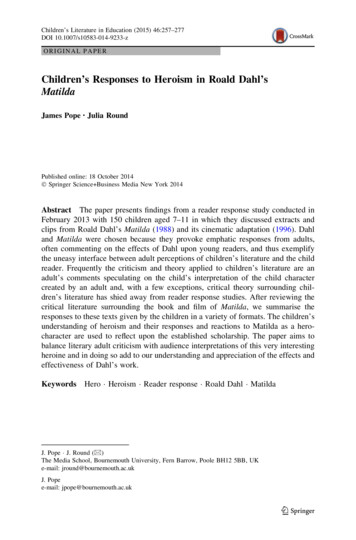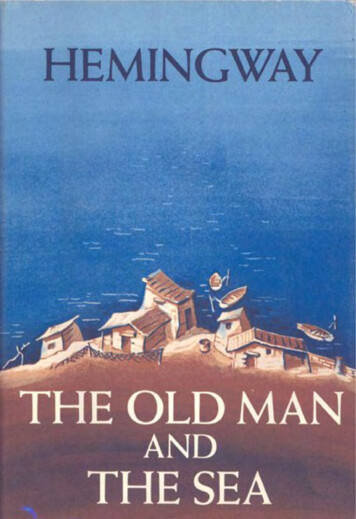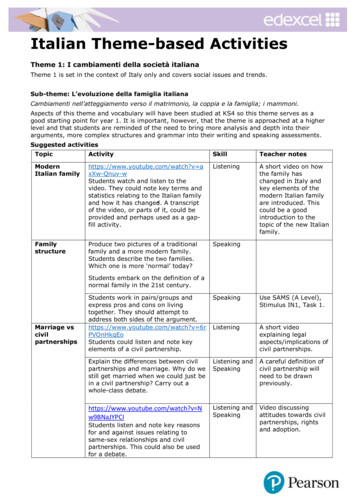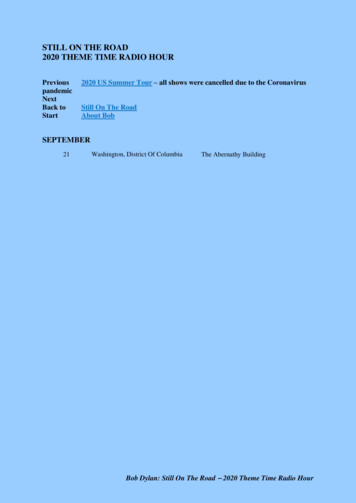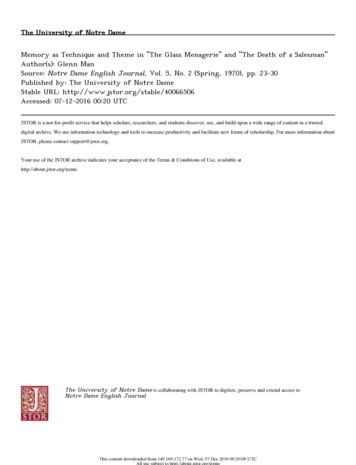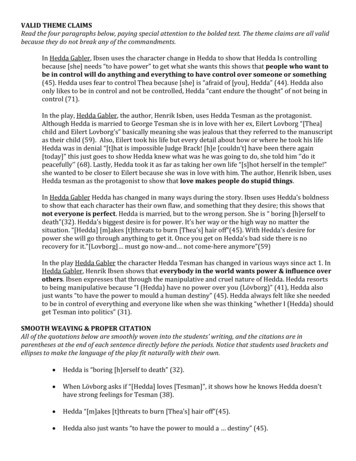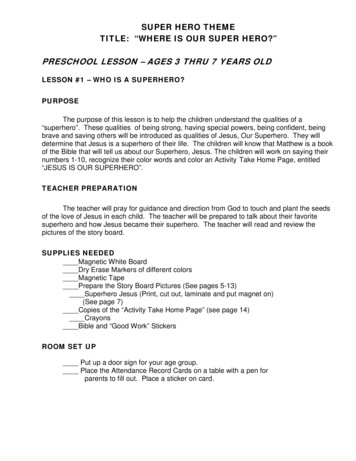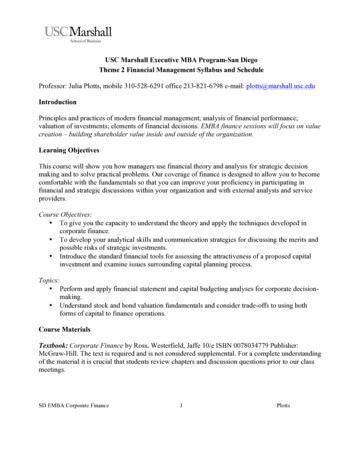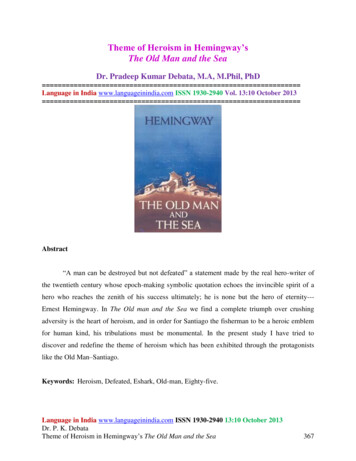
Transcription
Theme of Heroism in Hemingway’sThe Old Man and the SeaDr. Pradeep Kumar Debata, M.A, M.Phil, PhD Language in India www.languageinindia.com ISSN 1930-2940 Vol. 13:10 October 2013 Abstract“A man can be destroyed but not defeated” a statement made by the real hero-writer ofthe twentieth century whose epoch-making symbolic quotation echoes the invincible spirit of ahero who reaches the zenith of his success ultimately; he is none but the hero of eternity--Ernest Hemingway. In The Old man and the Sea we find a complete triumph over crushingadversity is the heart of heroism, and in order for Santiago the fisherman to be a heroic emblemfor human kind, his tribulations must be monumental. In the present study I have tried todiscover and redefine the theme of heroism which has been exhibited through the protagonistslike the Old Man–Santiago.Keywords: Heroism, Defeated, Eshark, Old-man, Eighty-five.Language in India www.languageinindia.com ISSN 1930-2940 13:10 October 2013Dr. P. K. DebataTheme of Heroism in Hemingway’s The Old Man and the Sea367
Hemingway’s Heroes and HeroismA man can be a hero because of unusual bravery, nobility of action, moral andintellectual qualities. Like Prometheus, Odysseus, Julia Caesar, Napoleon, a great number offigures are esteemed and respected as models for heroes because they represent the collectivedesire and yearning for being sublime, and grandeur. So the hero carries its traditional meaningand serves as a prototype for instruction, education and imitation. However, from the late 19thcentury, owing to the social, political and cultural changes, the hero in the contemporary worldbears different meanings.Hemingway’s heroes make a breakthrough in the connotation and transcend thetraditional function of heroes. Many of the characters in Hemingway’s novels and stories arecalled heroes because they still preserve some of the virtues of the romanticized figures and thenoble people in the traditional sense – bravery, courage, faith, perseverance, dignity, etc.Meanwhile, from their external action and internal mind, there always permeates a pessimisticmood and overtone. These heroes are more human than divine, more complex than simplex. Thevirtues Hemingway’s heroes show when facing the harsh reality serve not as models for peopleto follow but purely as the revelation of the consolation and comfort for the bitter agony andpains. Hemingway’s heroes are not always strong-minded, tough, sturdy, but rather dualized.Their courage, faith and moral code are rooted in the firm presumption that “Man proposes Goddisposes”.Language in India www.languageinindia.com ISSN 1930-2940 13:10 October 2013Dr. P. K. DebataTheme of Heroism in Hemingway’s The Old Man and the Sea368
Animated and RestrainedHemingway’s heroes are both animated as well as restrained, and seem to possess greatspiritual energy. His works capture the extremes of heroism and tragedy. His heroes convey asense of grandeur and power, and arouse strong emotion. In size, strength and emotionalintensity; these characters go beyond the real people. The novel The old man and the seadescribes the adventure of a single fisherman, highlighting his hard work, and his hard earnedprize, the huge marlin, which at last, falls prey to the hungry sharks. The novel points out thatHemingway’s aristocratic ideal of valour in battle is not the only the kind of heroism possible.Hemingway himself war correspondent, also praised the heroism of the man’s long silentstruggle with the earth and the elements. Hemingway’s story begins most lyrically describingmost the personal feeling instead of the acts of heroism portrayed in the epic struggle of the oldman and with the huge fish. The story begins depicting the interaction between the primarycharacters as they prepare their fishing gear for the following day near a Gulf Stream harbour inthe 1940s.The Power and NobilityThe power and nobility of Hemingway’s novels are resonant throughout the novel. Theopening profile is of Santiago , and ‘Old Man’ in the title, and the main character , throughoutthe story , basically speaking , he is depicted as the hero of the novel . But as heroic his hugmarlin, Santiago calls him his ‘brother’. He is a Cuban fisherman, described as being old inevery way except his eyes, which “were the same color as the sea and were cheerful andundefeated?” (p.5). Although Santiago has not caught a fish for eighty- four days, he ignoresthe Jeers and pity of other fishermen and returns to the sea in his skiff day after day . The oldman’s sail was “patched with flour sacks and. furled it looked like the flag of permanent defeat”(P.5). Other fisherman seems to believe that Santiago himself is a walking symbol of permanentdefeat, as he does not catch a fish for eighty-four days. Yet, when unfurled, the sail still carriesout its function, carrying Santiago out into the deepest water where the great marline awaits him.Likewise the old man proves himself when the time comes, giving a lasting impression ofendurance.Language in India www.languageinindia.com ISSN 1930-2940 13:10 October 2013Dr. P. K. DebataTheme of Heroism in Hemingway’s The Old Man and the Sea369
Manolin - Symbol of Youth, Potency and HopeThe second described is Manolin a young boy whom Santiago taught to fish. Manolinhad fished with Santiago before his parents made him stop , citing the old man ‘s fishlessstreak as “ the worst form of unlucky”(p.5). Despite working for another boat Manolin remainsSantiago one loyal friend, always willing to obtain meals coffee and bait for the penniless oldman, and more importantly to provide companionship. Hemingway seems to praise the idealsof freedom dignity of the individual; and heroism over coming tyranny–ideals characterizingthe American emancipation through the boy, Manolin. Even more so than the lions, the boyprovides Santiago with the ultimate symbol of youth potency and hope. More often than heprays to God for help, the old man recalls memories of Manolin wishing the boy were there - togive him strength in his time of need.The ForeshadowingAfter reminiscing about a fish that nearly ripped apart Santiago boat – foreshadowing theold man’s inevitable encounter at sea - they carry the sail, lines, and harpoon back to Santiagoshack, The foreshadowing continues as the old man’s anticipation for the following day offers,Eighty–five is a lucky number How would you like to see me bring one in that dressed outover a thousand pounds? (p.11). The boy brings Santiago supper, and they discuss their favouriteconversation topic: baseball-the New York Yankees and Joe DiMaggio. In particular Santiago’scontinual fixation with DiMaggio is an apt metaphor. The New York Yankees and JoeDiMaggio, whose career, Santiago follows in the Newspapers. DiMaggio – a two time AmericanLeague Most Valuable Player, and one of the greatest second half of this career. One of thebetter known injuries was the bone spur in the heel of his left foot, which limited his abilities.The Next year, however, DiMaggio Comeback with another MVP season. Santiago sees theGreat DiMaggio as an ultimate symbol of the resilience and courage- traits the old man showsthroughout his three day journey.Language in India www.languageinindia.com ISSN 1930-2940 13:10 October 2013Dr. P. K. DebataTheme of Heroism in Hemingway’s The Old Man and the Sea370
Dreams Every NightManolin leaves for the night, and Santiago sleeps, dreaming of the Africa he remembersfrom his youth. The old man dreams nightly of the African coast, as “ he no longer dreamed ofstorm, nor of women , nor of great occurrences , nor of great fish , nor fights , nor contests ofstrength nor of his wife . He only dreamed of places now and lions on the beach. They playedlike young cats in the dusk and he loved them as he loved the boy (p.19). Santiago was a sailor inhis youth, and travelled to Africa, where the young lion playing on the beach. Dreaming aboutthe lions each night provide Santiago with a link to his younger days, as well as the strength andidealism that are associated withSantiago rests, unawares that in the morning he will embark upon a three day journey ofepic proportions. Hemingway had a particular genius for tragedy. Like others American writersof his time, he dealt imaginatively with heroism and the apparent gap between the real and theideals. The gaps form the term of the Old Man and the Sea. In the novels, The Old Man and theSea, and A Farewell to Arms heroism is tied to the central characters confrontation withmortality. Just before sunrise on the second day, Santiago begins to pity the great fish towinghim. The old man reflects “He is wonderful and strange and who knows how old he is” (p.40). Ashared bond between the two is thus established, as Santiago has previously called himself ‘astrange old man’ (p.55), in addition old man begins to call the fish his brother, and revels that thehe loves and respects the fish. Throughout the rest of the novel Heming way details anddeepens the parallel between Santiago, who perseveres through the night to stay with his fishwho swims resiliently against the inevitability of death. Hemingway portrays the psychologicallyprobing story on themes such as heroism and honour.Three Key ImagesSantiago begins to feel the fish is slow, and he hopes the fish will jump, so that “he willfill the sacks along backbone with air and then he cannot go deep to die”. (P.44). The fish givesa sudden, unexpected pull which causes the fishing line to slice through Santiago’s hand. In spiteof his stained hand, which quickly begins to cramp, Santiago endures the pain and holds onLanguage in India www.languageinindia.com ISSN 1930-2940 13:10 October 2013Dr. P. K. DebataTheme of Heroism in Hemingway’s The Old Man and the Sea371
his line. Finally the fish jumps; a marlin which bulges out of the water ‘unendingly’ (p.52). ForSantiago, the fish that is two feet longer than his skiff is “the biggest fish that he had ever seenand bigger than he had ever heard of” (P.53). To comfort himself in the midst of his challenge,the old man thinks of the three key images throughout the book: The Great DiMaggio, the lionson the African beach, and the boy, Manolin. Santiago continually wishes that the boy were withhim, even though he knows that it is impossibility, yet, just the thought of Manolin seems to givethe old man strength and courage to endure.After catching a fish and eating it, the old man positions himself to get a few minutes ofsleep without losing his hold on the fish, determining that the marlin must “pull until he dies”(P.66). Santiago knows it is nearly time to kill the fish and again reassures himself by thinking“if the boy was here he would wet the coils of line, he thought. Yes. If the boy were here, if boywere here” (p.71). Santiago time of triumph quickly nears, yet the old man realizes that even ifhe catches the marlin his ideal is not over, as he thinks, “Man is not much beside the great birdsand beasts. Still I would rather be that beast down there in the darkness of the sea. ‘Unless sharkscome,’ he said aloud. ‘If sharks come, God pity him and me’ (p.57).Parallel SufferingSantiago awakes from his quick nap to the marlin jumping from the water more than adozen times. As the sun rises on Santiago’s third day fish finally begins to circle the boat.Although the marlin has weakened, the old man is also suffering from fatigue, as he begins toexperience faintness and dizziness, feels “tireder than I have even been” (p.76). Yet, Santiagorefuses to break down their physically or mentally, and continues working his great marlin closerto the skiff. Finally the marlin circles close enough for the old man to spear it with his harpoonwhich he drives in with all the strength he can summon . The dying fish musters its finalpower and “rose high out of the water showing all his great length and width and all his powerand his beauty. He seemed to hang to their air above the old man in the skiff. Then he fell in tothe water with a crash that sent spray over the old man and over all of the skiff” (p.80). As bloodfrom the marlin’s heart discolours the sea, Santiago attaches the marlin to the outside of the skiffwith the rope, and starts sailing for home.Language in India www.languageinindia.com ISSN 1930-2940 13:10 October 2013Dr. P. K. DebataTheme of Heroism in Hemingway’s The Old Man and the Sea372
Attack of SharksAs the old man‘s worst fears begins to come true, it is only “an hour before the first sharkhit him” (p.85). A mako shark, attracted by the trail of marlin blood attacks the attached fishripping out forty pounds before Santiago kills it with the harpoon. With the Marlin bleedingagain , and without his harpoon which went down with the bleeding again and without harpoonwhich went down the shark Santiago realize that his great prize , won after two long days ofstruggle may be destroyed much quicker. After the first attack the old man’s hope begins todiminish, and “he did not like to look at the fish any more since the he had been mutilated. Whenthe fish had been hit it was as though he himself were hit” (p.88). This continues to recall theparallels made earlier in the novel between Santiago and his marlin.Two more sharks arrive to feed on the Marlin, only to be killed by Santiago. Who ties hisknife to an oar to make substitute harpoon. The old man‘s knife snaps when he kills the nextshark leaving him with a club to use against the ceaseless barrage of sharks. As the sun goesdown on Santiago’s triumphant and tragic third day the old man recognizes the sharks is uselessbut continues clubbing them until they take the club from his hand s. Santiago resiliently useshis boat’s tiller as a weapon until it breaks the when he kills his last shark , and he realizes ,“That was the last shark of the pack that came. There was nothing more for them fo
ideals. The gaps form the term of the Old Man and the Sea. In the novels, The Old Man and the Sea, and A Farewell to Arms heroism is tied to the central characters confrontation with mortality. Just before sunrise on the second day, Santiago begins to pity the great fish towing him. The old man reflects “He is wonderful and strange and who knows how old he is” (p.40). A
